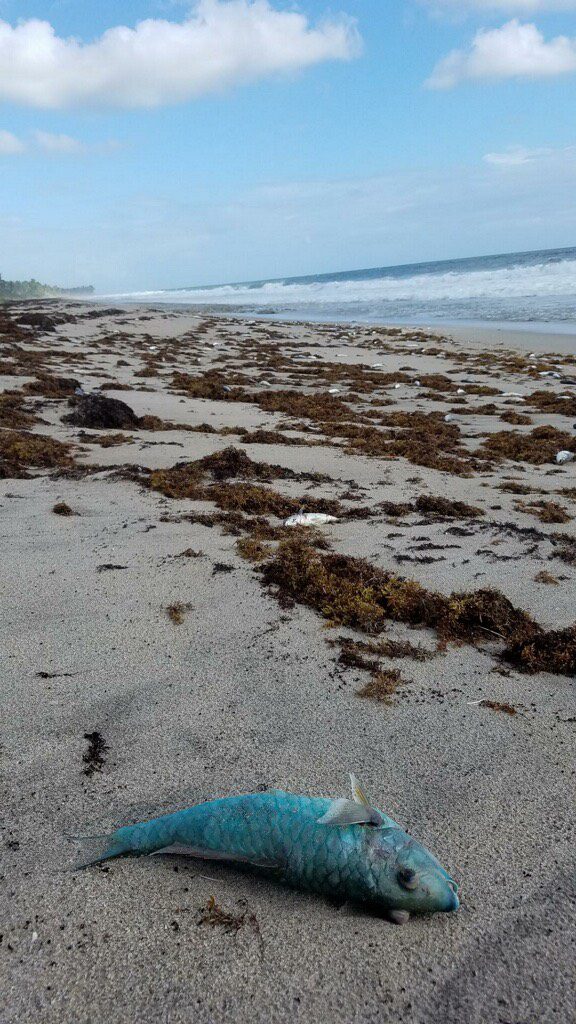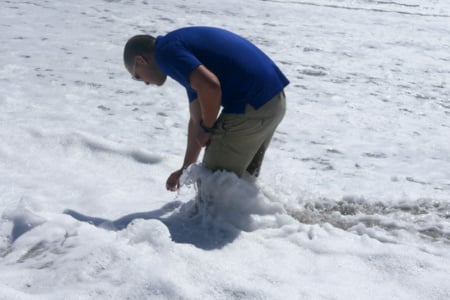Dr. Charles Manire, director of rehabilitation, & Dr. Justin Perrault, director of research, contributed to this blog.
In our effort to bring up to date information to our stakeholders and our community we have formulated updated information about red tide and its impact in Palm Beach County as of 5 p.m. on Wednesday, October 3.

Dead fish on local beaches:
Today on several County beaches, dead fish (also known as “fish kills”) are being reported washing ashore. FWC is collecting fish from our beaches and testing them for the presence of the red tide toxins. Results are expected in the next several days.
Many species of fish are very susceptible to brevetoxins resulting from red tides. These toxins are released as the Karenia brevis (the algal species that causes red tide) cells break open. They are absorbed through the fish’s gills fairly quickly, and this is why fish are usually the first organisms to die during a red tide event.
Regarding the consumption of seafood from the local waters, it is not safe to eat shellfish, but it is okay to eat finfish as long as they appear healthy when caught and are then filleted. Please view FWC’s Red Tide FAQ website for more information: myfwc.com/research/redtide/faq/
Red tide affects animals differently:
Because sea turtles are affected by the food they consume rather than toxins in the water, it usually takes longer for sea turtles to become affected by the brevetoxins, since food is the primary route of exposure in air-breathing organisms such as sea turtles.
In some red tide blooms, sea turtles may not be affected at all. Nonetheless, our research laboratory and our sea turtle hospital are on standby and prepared for whatever might come our way.
Daily water quality testing:

Testing of the sea water from our sea turtle hospital tanks today revealed very low quantities of Karenia brevis; however, this is not a cause for alarm at this time. These algal cells and the toxins that are released from the algae are not problematic until thousands to millions of cells are present in sea water.
Around the clock observation:
Patients in the Sea Turtle Hospital at Loggerhead Marinelife Center continue to behave and eat normally, giving no indication that they are affected by any toxins.
Because the primary route of red tide exposure for sea turtles is through their diet, we will not be feeding any local seafood to our patients. We receive our patients’ food supply from international sources, well outside the red tide area.
Hours of operations:
Loggerhead Marinelife Center, which operates out of Loggerhead Park, is open from 10 a.m. – 5 p.m. daily. Admission and parking are always free. For updates, please continue to check our blog and social media channels.
The Juno Beach Pier reopened on Wednesday, October 3 and is open 30 minutes before sunrise to sunset daily.
For more information about the Juno Beach Pier please visit: www.facebook.com/junobeachpier
We do not yet know when Palm Beach County will reopen local beaches.
Please help us expand our blood research and improve our patient outcomes for sea turtles affected by red tide:

In an effort to better respond to this and future red tide occurrences, LMC has launched our red tide rapid response blood research and detoxification lab. Our Research Laboratory has applied to multiple state and local organizations in an effort to request emergency funding for the equipment, medications and supplies required to monitor brevetoxin concentrations in sea turtles in a real-time, clinically significant manner.
This lab equipment and medication will allow our scientists and medical staff to serve as a regional collaboration hub, providing rapid testing to identify the presence of the red tide toxins to multiple local rehabilitation facilities, so they can develop the most effective treatment plans for affected sea turtles.
Loggerhead Marinelife Center’s Go Fund Me Page can be found at: www.gofundme.com/lmc-red-tide-emergency-fund
